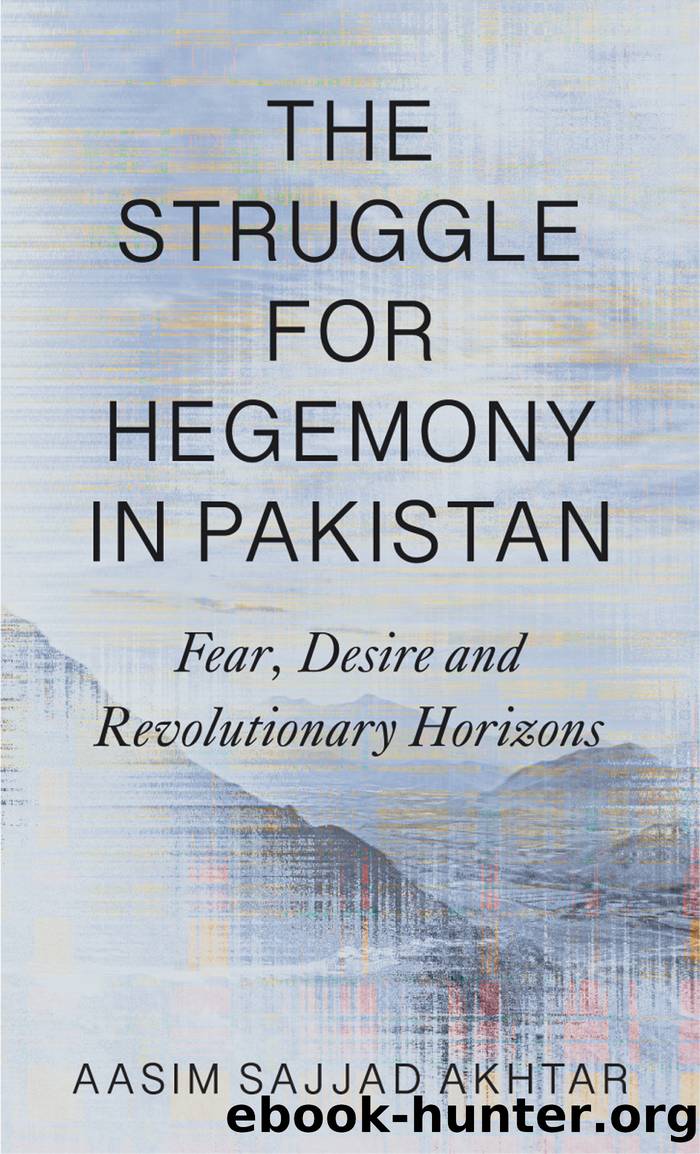The Struggle for Hegemony in Pakistan by Sajjad Akhtar Aasim;

Author:Sajjad Akhtar, Aasim;
Language: eng
Format: epub
Publisher: Pluto Press
OF MANY PUBLICS
Structural transformations through time and space have produced new middle-class subjects while transforming the hegemonic apparatus itself. In Gramsciâs words, a hegemonic apparatus in any particular conjuncture âcreates a new ideological terrain, determines a reform of consciousness and of methods of knowledgeâ. In no uncertain terms, the digitalised field of politics represents a new ideological terrain that is transforming consciousness â of self and the social world at large â through novel methods of knowledge.7
I have argued that contemporary middle-class hegemony has been preceded by two distinct moments in Pakistanâs history that have also been hegemonised through a middle-class political subject. All three moments have corresponded to both an idealised as well as a practical manifestation of the âpublicâ, within which, in turn, all historically specific forms of âthe politicalâ have taken form. In a nutshell, neither the âpublicâ nor âthe politicalâ is static; in fact, as I will discuss presently, the quest for hegemony is a struggle between multiple âpublicsâ as much as competing conceptions and political practices.
My point of departure is Nancy Fraserâs seminal critique of the Habermasian ideal-type âpublic sphereâ in which nominally âequalâ citizens engage in voluntary deliberation and thereby buttress processes of democratisation.8 Actually existing western society, Fraser asserts, has been historically constituted through sexist, racist, class and other structures that continue to shape social relations, and, therefore, access to the public sphere. She proposes the alternative normative ideal of multiple publics so as to ensure a meaningful voice for the âunequalsâ that comprise contemporary capitalist society.
Read as a general critique, Fraserâs argument can ostensibly account for any number of societal contexts. Yet, the specificity of the (post) colonial public sphere demands interrogation in its own right. Habermasâ conceptualisation of the public sphere was, after all, based exclusively on Europeâs distinct experience of bourgeois modernity. Kaviraj notes that âin Indian society there was a rich repertoire of concepts of common responsibility, obligation, action, that did not share the characteristic features of bourgeois publicity like a recognisable source, proper authorization, impersonality, legality, state sanction, and clear ascription of individual responsibilityâ.9
The colonial interregnum, then, brought into existence distinct norms and practices of publicity that had little organic basis within Indian society per se, instead imposing âfrom aboveâ officially-mandated norms that corresponded to the dictates of state and capital. Pride of place in the officially constituted public sphere was of course accorded to the men of letters that were âIndians in blood but English in tasteâ, at least some of whom, it is worth reiterating, hailed from big landed families.
This explicitly insular domain corresponded to sanitised forms of âthe politicalâ; less than 12% of the total population was entitled to vote in provincial elections held in colonial Punjab under the 1935 Government of India Act.10 Eventually, the contradictions of colonial statecraft and its associated legal instrumentalities â rooted in a hybrid property rights regime in which capital accumulation was interwoven with the geopolitical imperatives of Empire â exploded the âofficialâ public sphere from within. Both a
Download
This site does not store any files on its server. We only index and link to content provided by other sites. Please contact the content providers to delete copyright contents if any and email us, we'll remove relevant links or contents immediately.
The Secret History by Donna Tartt(18096)
The Social Justice Warrior Handbook by Lisa De Pasquale(11944)
Thirteen Reasons Why by Jay Asher(8426)
This Is How You Lose Her by Junot Diaz(6414)
Weapons of Math Destruction by Cathy O'Neil(5804)
Zero to One by Peter Thiel(5467)
Beartown by Fredrik Backman(5320)
The Myth of the Strong Leader by Archie Brown(5219)
The Fire Next Time by James Baldwin(4998)
How Democracies Die by Steven Levitsky & Daniel Ziblatt(4943)
Promise Me, Dad by Joe Biden(4900)
Stone's Rules by Roger Stone(4837)
100 Deadly Skills by Clint Emerson(4671)
Rise and Kill First by Ronen Bergman(4537)
A Higher Loyalty: Truth, Lies, and Leadership by James Comey(4535)
The David Icke Guide to the Global Conspiracy (and how to end it) by David Icke(4363)
Secrecy World by Jake Bernstein(4360)
The Farm by Tom Rob Smith(4311)
The Doomsday Machine by Daniel Ellsberg(4234)
